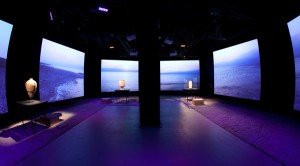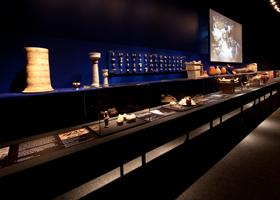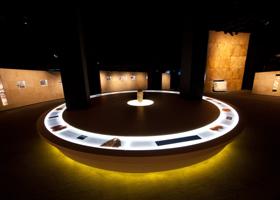The Dead Sea Scroll exhibition tells the story of the foundation of three religions, in terms of ancient texts and times. The scrolls are more than 2,000 years old, written mostly before Jesus’s time.

When you enter, you’ll be in the room above, pictures/movies that change depending on what your guide is telling you. You’ll hear about the three jars – their origin and times, while seeing scenes of Israel and the area in historical context – the Dead Sea, digging at an archaeological site, the Western Wall, and more.
The jars you see are original, though restored. Know that the scrolls you see are more than 2,000 years old, containing the oldest known copy of the Hebrew bible. Altogether they have more than 500 artifacts at the exhibit.
THE STORY: The scrolls were found in the Qumran caves, which rise above the world’s lowest spot, the Dead Sea, at 1,400 feet below sea level. If you haven’t been, the Dead Sea is other-worldly, since it’s so dry the water is evaporating from the sea, leaving behind salt formations. These dry conditions were perfect for preserving scrolls, wrapped in linen and stored in jars, tucked away in caves.
While the story is long, the basics are that a Bedouin shepherd boy threw a rock in a cave when looking for a goat in 1947, just before Israel became a state. He heard something break, and came back later to investigate. He found scrolls, selling them through a dealer (long story here). Eventually the Israeli government was able to buy the scrolls back.

The first part of the exhibition is objects like you see above, with some history explaining why the objects are as they are. My kids were fascinated to know that the Jewish religion wasn’t the same then as now, and that religion continues to change and evolve. During these times, some people had altars in their homes where they offered sacrifices (incense, though the altars decorated with horns, reminiscent of animal offerings). My son was shocked to see that some of the Jews had “idols” in their homes, in the form of fertility goddesses.
On exhibit are a lot of jars, including some from King Hezekiah’s reign, used possibly as tax collection containers. They show royal stamps on the handles.
The Hebrew bible was written during the biblical era (duh!) which was also known as the Iron Age – 1200-550 BCE. BCE is the Jewish way of saying BC – instead of Before Christ, it’s Before Common Era. CE is Common Era, used instead of AD. While we’re talking about meanings, bible means library.

The kids liked seeing the small scale and weights used during that time – the weights were small stones, and the weight of measurement was called a shekel (which meant weight). Shekels are the currency used in modern Israel, only now it’s coins and paper money. Then, they used a barter system, and weighed silver to exchange for goods. Each shekel weighed 11.4 grams.
There were a few other objects that were fun for the kids to guess their use, including a terracotta bathtub (which looked like a bathtub) and ossuaries (which held bones of deceased relatives).
As for the scrolls, there are several types exhibited (around in the circle below). Some are original documents (see the community rule below), and some are copies (hand-written copies of preexisting books). They date from the 3rd century BCE to the 1st, and even up to the destruction of the community in 68 CE, at the hands of the Romans.
I enjoyed seeing Leviticus 23:22-29, which is the basis for Yom Kippur, the Jewish day of atonement. It also talks about farmers leaving part of their fields unharvested, for the poor and the stranger to come and take. There’s a portion of the Psalms. Apparently archaeologists found 32 copies of Deuteronomy, covering all portions of that book. Also on exhibit was a segment about community rules, regulations for the group who lived in the desert.
CONTROVERY: There’s a raging controversy swirling around the scrolls concerning who wrote them, and the exhibition’s point of view. I won’t comment on it, other than saying the controversy exists.

MOVIE: I recommend you and the kids watch the movie (it’s free) about how the Dead Sea Scrolls were discovered. And sold. And handled. The scrolls made their way from a Bedouin to a dealer, to purchasers and then finally to the Israeli government (by way of the Wall Street Journal). Archaeologists finally found the site, hiring Bedouins to help excavate. It turned into a race between them as the Beduoins realized they could make additional money selling the scrolls, and found about half of the scrolls on their own after hours. They found the best cave (#4) which apparently had about 50% of the scroll materials found in all. Read the Dead Sea Scroll discovery story here, which tells it much better than I can.
The fragments found were assembled by biblical scholars, some of who were smoking cigarettes while they put them back together. Using scotch tape and glue from postal stamps. Obviously restoration has come a long way since then!
10 COMMANDMENTS: Through January 2, you can see the best preserved and oldest copy of the 10 commandments. It was too small for me to read (and covered in a layer of gauze or something to hold it together) but awesome nonetheless.

WHAT THE KIDS THOUGHT: My 10-year-old said she liked it more than she expected. She liked seeing the parchment fragments and the other artifacts. She was excited to see a piece of the Western Wall. (You can leave notes/prayers on the wall segment, just as you can at the Wall in Jerusalem). My 8-year-old initially said “this is more interesting than I thought it would be,” and that was during the first part of the exhibition, where they had jars and small objects. The kids got bored pretty quickly after that, since reading about ancient Israeli history isn’t so exciting to kids who would rather be playing video games. But I do think they absorbed some while there, and got to see some great artifacts that they wouldn’t get to see outside of Israel.
HOW LONG WILL YOU SPEND THERE? You may have to wait 15 minutes or so to get into the exhibit, since they let you in as a group. That’s assuming you have timed tickets and there’s not a lot of people in front of you (otherwise you’ll have to wait longer). There’s a short live narration before you’re set loose. We spent about an hour in the exhibition, which was not enough time for me, but more than enough time for the kids.
AUDIO: You can rent an audio player for an additional fee. We did not rent it, since I don’t think the kids would have lasted much longer with it. If I were to go back on my own, I would.
FACILITY: The Discovery Exhibition Center also has the CSI exhibition (read review here). There’s a Cake Boss bakery (with packaged kosher treats also) and good gift shop. You can’t leave the Scrolls exhibit and come back in, so use the bathroom first. There’s a free coat check, which also accepts packages, strollers and backpacks.
TICKETS: The Dead Sea Scrolls Exhibition runs in Times Square through April 15, 2012. Tickets are $27 for adults, $22.50 for seniors, $19.50 for kids ages 4-12.
DISCOUNTS:
-Costco sells tickets in the store for $19.99 (up to 43% off). Not sold online. Tickets seen at Union, NJ Costco.
-When in the city, look for flyers anywhere there are tourist flyers, (like in Penn Station) – and you can get a $5 off code. I believe you can use it online when getting tickets. The code is CTMDSS.
-Get $5 off at Broadway Box using code BBOX10.
-Groups of 10+ can get discounted group tickets by calling 855-266-5387.
-Those taking the LIRR to the exhibit can save up to 40% on train and exhibit tickets through this MTA deal.

Very good review. I went to the exhibit right before Thanksgiving with a friend and enjoyed it. I am impressed that you brought your children. I figured my son would be bored. I am jealous that you were able to see the 10 commandments. Also, how did you get to take pictures?
My kids were a little bored, so we didn’t stay as long as I would have liked. That’s the trade off when bringing kids! The 10 commandments were interesting, partly because they were so small. They had a blown-up version showing where they were on the scroll (the scroll contained more than just the commandments). I wouldn’t know where they were on the scroll without the translation (though I can read some Hebrew). As for the photos, they were press photos – not mine.